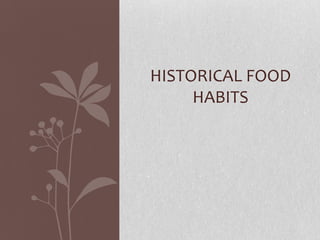
HISTORICAL FOOD HABITS DATA
- 1. HISTORICAL FOOD HABITS
- 2. Goals for the Historical Food Habits project a) Safeguard data (electronic storage) • Scan all cards to hard drives (pdf image files) b) Safeguard cards (physical storage) • After scanning, move cards to safe long-term storage c) Transform currently inaccessible data into globally accessible usable information (i.e. searchable online database)
- 3. Data Fields for each card Header (general data: easy to read and comprehend): • Biological data for the collected specimen (genus, species; sex and age in some cases) • Card number (accession number) • Locality (town, state) • Where killed (habitat) • Date (month, day, year) • Hour (time of death) Food Habits (‘stomach’ contents - specialist data): • Characterized contents (either percentages or counts of specific plant and animal material e.g. Gastropoda, C. florida ) • Collector (name and sometimes a collector number) • Condition of stomach/gullet (how full) • Percentage of: - animal matter - vegetable matter - Gravel, rubbish etc. • Examination date, examiner name
- 4. Example cards, with entertaining oddities - Card number (42444) is high for the very early collection date (1876) - Is this an error? There are other cards with similar dates/numbers - 24 years elapsed between sample collection and food contents analysis (1910). That’s a long time to float in formalin! - Can YOU read Beal’s handwriting?
- 5. Example of food habits data* (Eastern Meadowlark – non-plant food) • Rhyncophorus Popillia Tettix Corimelaena • Sphenophorus Chlaenius Spizella Andrena Cotinis • Melanoplus Anomala Protoparce Amara Desmocerus Colaspis • Systena Anisodactylus Campanotus Coriscus • Coenus Lebia Corticana Lygus • Sitones Microtus Tiphia Wacrosiphum • Armadillidium Metriona Oedionychis • Melampus Monocrepidius Tettigidea • Casnonia Syneta Crepidodera • Harpalus Platypus Baris Carabus Limonius • Phytonomus Mus Odontota • Tenebrio Chaetocnema Julus • Leucania Macrops Peromyscus • Aphodius Agrotis Euphoria • Epicauta Gryllotalpha Dibolia • Lachnosterna Melanotus Epitrix • Omophron Entamia Graphops Centrinus • Myrmica Corymbites Necrophorus Apina • Gryllus * Frequent “???! due to Beal’s illegibility Cillenum Tanypus omitted
- 6. Feasibility trial to evaluate data entry • Select high profile species (Wood thrush) with representative card complexity DONE • Review summary sheets to outline extent of dataset DONE • Scan cards DONE, pdf format • Enter header data DONE, via Excel • Review food habits data entered via Access DONE* • Share resultant dataset with Consortium colleagues to determine best: • online host for ~250,000 pdfs (est. 75 gb) for transcription • data entry system for generalist header data transcribed from pdfs • data entry system for specialist food habits data transcribed from pdfs * Thanks to Haas, Gorman et al.
- 7. Hylocichla mustulina (Wood Thrush) Submissions by state 60 50 Total = 180 Gender: Unknown 81 40 Female 38 Male 61 30 20 10 0 PA WI Canada CT FL IL KS MA VA ME SC NY AL GA MI NC NJ TX MS DC TN Draft
- 8. Hylocichla mustulina (Wood Thrush) Submissions by year (180 total) 20 18 16 14 12 10 8 6 4 2 0 1879 1933 1885 1891 1897 1936 1882 1900 1909 1927 1930 1894 1921 1876 1915 1888 1912 1924 1903 1906 1918 Draft
- 9. Citations collected during HFHabits study demonstrate its perspective : how do these species affect humans? Birds of CT – Bishop - 1913 1912
- 10. Header field issues affecting data entry system design Header (general data): • Biological data: • Species name changes (Turdus mustelina became Hylocichla mustelina) • Gender noted ~ 50% of the time; age rarely (juvenile/immature or adult) • Card number (accession). • Never omitted. Number unrelated to species, date, location. (Likely collectors were handed out-of-sequence stacks of cards whenever they ran out. ) • Locality (town, state) • Rarely omitted but inconsistent names. • Where killed (habitat). • Neither specific nor consistent terminology e.g. : Woods, woodland and field, upland grove, timber, cedar grove, rocky woods, oak grove, thicket, low woods, hemlock woods, hardwoods, near woods, deep woods, deciduous woods, near woodlands. • Date (month, day, year) • Consistently included. • Hour (time of death) • Included much more often than gender of sample unfortunately.
- 11. Gordian knot approach for data entry To transform currently inaccessible data to globally accessible, accurately transcribed and usable information: Separate the entry process into two independent but linked parts : 1. Header - generalist data fields a) Themselves valuable research data b) Predominantly clearly written and straight-forward therefore easy to enter (Can be read, entered and proof-read by just about anybody) c) Once entered online they characterize the entire database, opening it to any investigator including specialists d) Focus on these fields first 2. Food habits - specialist data fields a) Predominantly unclearly written and require specialist (entymologist, botanist, etc.) expertise to interpret and enter online b) Principal investigators focused on this area of research are the most likely to commit resources (grants, grad students, etc.) to wringing out the information – we don’t have the resources
- 12. Please let us know: Thoughts at this point on the best … • Online host for scanned images and linked evolving database? • American Bird Network? SORA? Biodiversity Universe? • Data entry system linked with scanned cards for both: 1. Header data (generalist input) 2. Food habits data (specialist input) • Access? • Zooniverse and its Scribe system? • Other?
